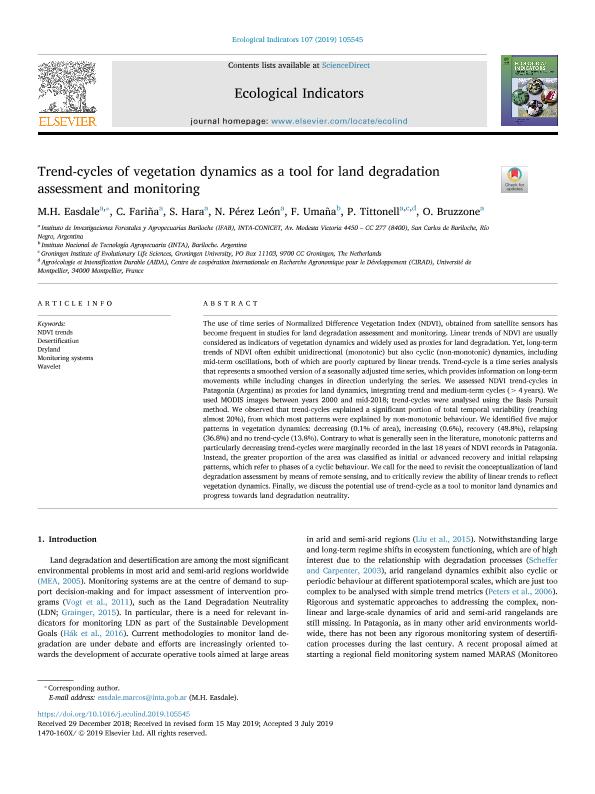Artículo
Trend-cycles of vegetation dynamics as a tool for land degradation assessment and monitoring
Easdale, Marcos Horacio ; Fariña, Clara María; Hara, Sofía María
; Fariña, Clara María; Hara, Sofía María ; Pérez León, Natalia; Umaña, Fernando Javier; Tittonell, Pablo
; Pérez León, Natalia; Umaña, Fernando Javier; Tittonell, Pablo ; Bruzzone, Octavio Augusto
; Bruzzone, Octavio Augusto
 ; Fariña, Clara María; Hara, Sofía María
; Fariña, Clara María; Hara, Sofía María ; Pérez León, Natalia; Umaña, Fernando Javier; Tittonell, Pablo
; Pérez León, Natalia; Umaña, Fernando Javier; Tittonell, Pablo ; Bruzzone, Octavio Augusto
; Bruzzone, Octavio Augusto
Fecha de publicación:
12/2019
Editorial:
Elsevier Science
Revista:
Ecological Indicators
ISSN:
1470-160X
Idioma:
Inglés
Tipo de recurso:
Artículo publicado
Clasificación temática:
Resumen
The use of time series of Normalized Difference Vegetation Index (NDVI), obtained from satellite sensors has become frequent in studies for land degradation assessment and monitoring. Linear trends of NDVI are usually considered as indicators of vegetation dynamics and widely used as proxies for land degradation. Yet, long-term trends of NDVI often exhibit unidirectional (monotonic) but also cyclic (non-monotonic) dynamics, including mid-term oscillations, both of which are poorly captured by linear trends. Trend-cycle is a time series analysis that represents a smoothed version of a seasonally adjusted time series, which provides information on long-term movements while including changes in direction underlying the series. We assessed NDVI trend-cycles in Patagonia (Argentina) as proxies for land dynamics, integrating trend and medium-term cycles (>4 years). We used MODIS images between years 2000 and mid-2018; trend-cycles were analysed using the Basis Pursuit method. We observed that trend-cycles explained a significant portion of total temporal variability (reaching almost 20%), from which most patterns were explained by non-monotonic behaviour. We identified five major patterns in vegetation dynamics: decreasing (0.1% of area), increasing (0.6%), recovery (48.8%), relapsing (36.8%) and no trend-cycle (13.8%). Contrary to what is generally seen in the literature, monotonic patterns and particularly decreasing trend-cycles were marginally recorded in the last 18 years of NDVI records in Patagonia. Instead, the greater proportion of the area was classified as initial or advanced recovery and initial relapsing patterns, which refer to phases of a cyclic behaviour. We call for the need to revisit the conceptualization of land degradation assessment by means of remote sensing, and to critically review the ability of linear trends to reflect vegetation dynamics. Finally, we discuss the potential use of trend-cycle as a tool to monitor land dynamics and progress towards land degradation neutrality.
Palabras clave:
NDVI TRENDS
,
DESERTIFICATION
,
DRYLAND
,
WAVELET
Archivos asociados
Licencia
Identificadores
Colecciones
Articulos (IFAB)
Articulos de INSTITUTO DE INVESTIGACIONES FORESTALES Y AGROPECUARIAS BARILOCHE
Articulos de INSTITUTO DE INVESTIGACIONES FORESTALES Y AGROPECUARIAS BARILOCHE
Citación
Easdale, Marcos Horacio; Fariña, Clara María; Hara, Sofía María; Pérez León, Natalia; Umaña, Fernando Javier; et al.; Trend-cycles of vegetation dynamics as a tool for land degradation assessment and monitoring; Elsevier Science; Ecological Indicators; 107; 12-2019
Compartir
Altmétricas



